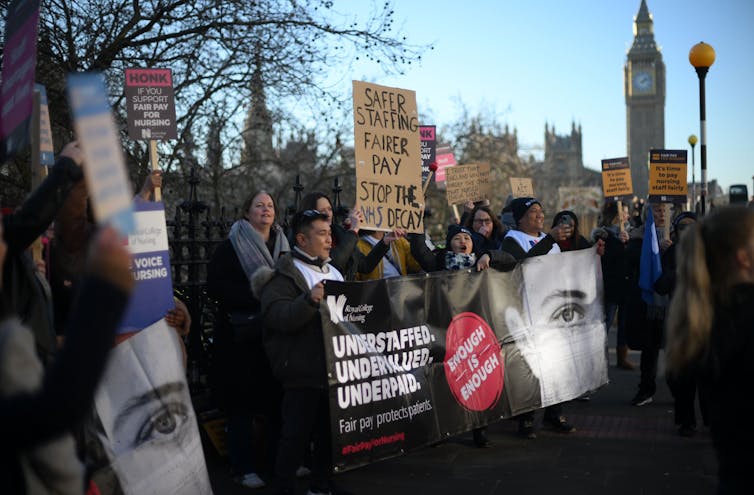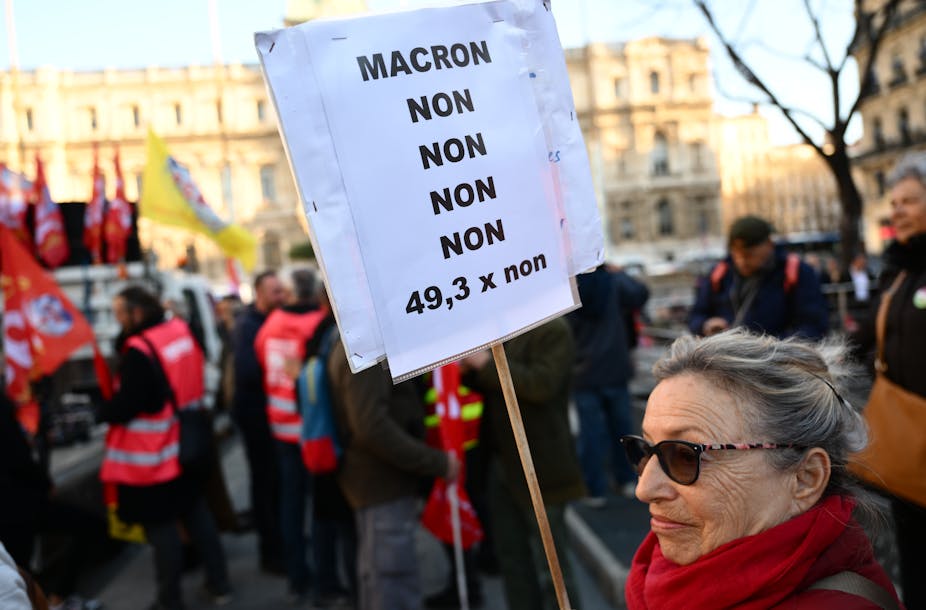Wednesday 15 March was a historic day of strikes in both the United Kingdom and France. For France it was the eighth day of protests against reforms that would raise the retirement age from 62 to 64. Although the movement is losing traction, the protests are large even by French standards and are the biggest since 1995. And in yet perhaps the most dramatic twist of two months of unrest, on Thursday 16 March, Emmanuel Macron’s government resorted to passing the reform without a vote – a procedure enabled by article 49, paragraph 3 of the French constitution, often referred to as “49.3”. MPs opposed to the move have until Friday afternoon to submit no-confidence votes.
In the UK, a series of ongoing disputes on pay across a number of sectors including local government, education and railways culminated in strikes coordinated to coincide with the spring budget announcement on 15 March. The scale of the industrial action makes the British strikes historic, particularly when taking account of the highly restrictive legal framework.
How do the two countries’ movements measure up against each other? What are the “sticking points” that bring workers out on strike in both countries, and how are their governments reacting?
How significant are the strikes?
In both France and the UK, the strikes of 2022-23 are considered historic moments of industrial conflict, with references to record-strike years framing each movement.
In the UK, the main reference is 2011, which represented the “biggest outbreak of industrial unrest in three decades”. At the time, 2 million public-sector workers walked out, and over 60% of schools shut down. As in 2011, the disputes in 2022-23 are mostly over pay, with unions calling for wage rises to keep up with inflation. The action escalated in February and March 2023 and now includes more than 400,000 public sector workers, from sectors spanning education, health care, the civil service and the railway network.
But Wednesday’s spring budget brought a new impetus to the movement. Spanning 154 government departments, the Public and Commercial Services (PCS) union, which represents civil servants, called for a 10% pay rise, better pensions, job security and no cuts to redundancy terms. Junior doctors also walked out over pay, which the British Medical Association says has shrunk by 26% since 2008 once inflation is taken into account. Meanwhile, teachers striking on 15 and 16 March rejected a government offer of an extra 1.5% pay rise, plus 1.5% as a one-off payment.
In France, comparisons are made between the current strikes and those in 1995, when the country was brought to a standstill with strikes against the so-called Juppé reforms, an austerity package including measures to restrict pensions. At the movement’s peak, more than 2 million people took to the streets and public support was high, forcing the government to withdraw the project. The failure in 1995 meant that subsequent governments viewed pension reforms as being politically risky.
In 2022-23, as in 1995, the change in retirement age is the main grievance. There have been eight days of national strikes and demonstrations so far against the reforms, with calls to bring France to a standstill on 7 March, and the eighth strike on 15 March. As in the UK, the French government has used broader economic arguments about public spending to push forward with the reforms, which passed the Senate on 11 March.
Does the public back the strikes?
In the UK, public support has been high for the strikes, particularly for workers such as nurses and paramedics. For the first time its 106-year history, the Royal College of Nursing (RCN), the UK’s largest nursing union, voted to take strike action in 2022. Ambulance drivers and paramedics have also walked out. While pay is a sticking point, the grievances also included issues linked to staffing levels and working conditions.
Meanwhile, there is also sympathy for the strikes in France. Polling has shown around 70% of the public reject Macron’s pension reform plans and a petition opposing the reforms has gathered over 1 million signatures.
Strike action in the UK is subject to complex legislation. While there is no legal right to strike, it’s legal if organised by a trade union according to conditions laid out in the Trade Union and Labour Relations (Consolidation) Act 1992. A union must first be recognised by the workplace it is active in, and have raised a dispute on behalf of its members. It may then ask its members weigh in by post – called a “ballot to strike”.

The 2016 Trade Union Act introduced new restrictions. As of 2017, industrial ballots must attract a 50% turnout for their results to be considered legally valid. Workers whose role mostly concerns the delivery of “essential” public services (including some workers outsourced to private companies) have to reach a 40% support threshold among all workers eligible to vote, as well as the 50% turnout threshold, in order to take action.
In France, striking as a civil right
In contrast, in France, withholding labour is an individual civil right, whether one is a union member or not – indeed, the right to strike is guaranteed by the Constitution. It is an individual right that is to be exercised collectively. In other words, it is necessary for several employees of a company to decide, together, that they will stop work as a means of furthering work-related demands.
There are certain rules that need to be respected, particularly in the public sector (i.e., giving 48 hours’ notice of intention to strike, minimum service provisions for sectors like transport and health), but there are few restrictions in the private sector.
Even though the strikes have been well supported, the French government is looking set to force through the reforms. Given the legal restrictions on strikes in the UK, the level of participation and attempts at coordinated action across sectors is impressive, and proof of a belief in British society that collective action is a viable solution. And strikes are starting to yield their fruits, as evidenced by the government’s recent pay increase offers in the health sector.
Yet, to what extent are governments willing to push toward anti-liberal restrictions to quell strike movements? In France, extending the minimum service legislation, for refuse workers, for example, might lead to tougher conditions for strikers. In the UK, the Conservative government’s proposed legislation to implement minimum service arguably moves the right to strike in the UK “beyond neoliberalism” toward a more authoritarian state. The government has justified the implementation of minimum service levels using France as an example of where this legislation exists. This comparison does not take into account the very different legislative frameworks on the right to strike.

